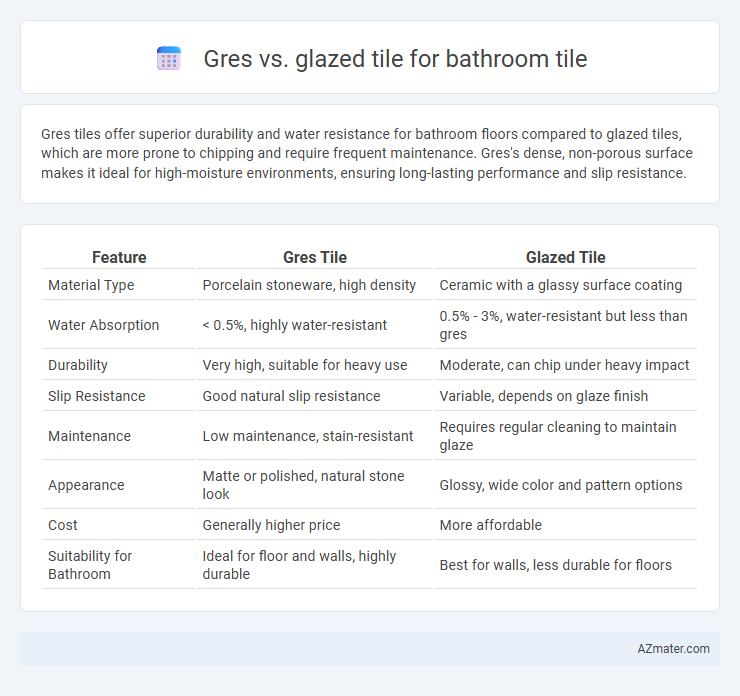Gres tiles offer superior durability and water resistance for bathroom floors compared to glazed tiles, which are more prone to chipping and require frequent maintenance. Gres's dense, non-porous surface makes it ideal for high-moisture environments, ensuring long-lasting performance and slip resistance.
Table of Comparison
| Feature | Gres Tile | Glazed Tile |
|---|---|---|
| Material Type | Porcelain stoneware, high density | Ceramic with a glassy surface coating |
| Water Absorption | < 0.5%, highly water-resistant | 0.5% - 3%, water-resistant but less than gres |
| Durability | Very high, suitable for heavy use | Moderate, can chip under heavy impact |
| Slip Resistance | Good natural slip resistance | Variable, depends on glaze finish |
| Maintenance | Low maintenance, stain-resistant | Requires regular cleaning to maintain glaze |
| Appearance | Matte or polished, natural stone look | Glossy, wide color and pattern options |
| Cost | Generally higher price | More affordable |
| Suitability for Bathroom | Ideal for floor and walls, highly durable | Best for walls, less durable for floors |
Introduction: Choosing the Right Bathroom Tile
Gres tile, known for its dense, non-porous composition, offers superior water resistance and durability, making it ideal for high-moisture bathroom environments. Glazed tiles feature a glass-like coating that provides a smooth, colorful finish and enhanced stain resistance, perfect for decorative bathroom walls and floors. Selecting between gres and glazed tiles depends on balancing durability needs with aesthetic preferences to ensure long-lasting bathroom surfaces.
What Is Gres Tile?
Gres tile, also known as porcelain stoneware, is a dense, durable material made from fine clay and fired at high temperatures, making it highly resistant to water, stains, and wear. Unlike glazed tiles, gres tiles typically have a uniform color and texture throughout the body, which helps them maintain appearance even if scratched or chipped. Their low porosity and robust structure make gres tiles an ideal choice for bathroom floors and walls where moisture and heavy foot traffic are common.
What Are Glazed Tiles?
Glazed tiles are ceramic or porcelain tiles coated with a glass-like substance that is fused to the surface through a high-temperature firing process, resulting in a shiny, waterproof, and stain-resistant finish ideal for bathroom applications. This glazing enhances the tile's durability and allows for a wide range of colors, patterns, and textures, making glazed tiles both functional and aesthetically versatile for bathroom walls and floors. Compared to gres tiles, glazed tiles offer superior moisture resistance and easier maintenance, which is crucial for wet environments like bathrooms.
Key Differences Between Gres and Glazed Tiles
Gres tiles are made from dense, unglazed porcelain that offers high durability and low water absorption, ideal for wet bathroom environments. Glazed tiles feature a glass-like coating that provides a wide range of colors and patterns but may be more prone to chipping and wear over time. The choice between gres and glazed tiles depends on the balance between functional strength and aesthetic versatility required for bathroom flooring or walls.
Water Resistance and Durability Comparison
Gres tiles, known for their low porosity and high-density composition, offer superior water resistance making them ideal for bathroom environments prone to moisture. Glazed tiles feature a glass-like coating that enhances water resistance but can chip over time, compromising durability. The dense structure of gres tiles ensures long-lasting performance and resistance to wear, whereas glazed tiles may require more frequent maintenance due to surface vulnerabilities.
Slip Resistance: Safety Considerations
Gres tiles, made from dense porcelain, offer superior slip resistance due to their textured surfaces and low water absorption rates, making them safer for bathroom environments. Glazed tiles, while visually appealing with a glossy finish, tend to be more slippery when wet, increasing the risk of accidents. Selecting gres tiles for bathroom flooring enhances safety by minimizing slip hazards without compromising durability or aesthetics.
Design & Aesthetic Options
Gres tiles offer a sleek, matte finish with natural stone-like textures that enhance minimalist and modern bathroom designs, while glazed tiles provide a glossy surface with vibrant colors and intricate patterns ideal for creating focal points or decorative accents. The durability of gres tiles complements industrial and contemporary aesthetics, whereas glazed tiles lend themselves to versatile style options ranging from classic to eclectic due to their varied finishes and customizable motifs. Both tile types support sophisticated bathroom aesthetics, but the choice depends on the desired visual impact and maintenance preferences.
Maintenance and Cleaning Requirements
Gres tiles offer low water absorption and high resistance to stains, making maintenance straightforward with simple sweeping and mopping using mild detergents. Glazed tiles feature a smooth, non-porous surface that resists moisture and dirt, allowing for easy cleaning with regular household cleaners and minimal grout maintenance. Both options provide durable, hygienic surfaces ideal for bathrooms, but glazed tiles generally require less frequent deep cleaning due to their enhanced surface protection.
Cost Analysis: Gres vs Glazed Tiles
Gres tiles generally offer a cost-effective solution compared to glazed tiles, with prices ranging from $3 to $10 per square foot depending on quality and design. Glazed tiles, featuring a glass-like coating, can be more expensive, typically costing between $5 and $15 per square foot due to enhanced aesthetics and water resistance. Installation costs for both tile types remain similar, but gres tiles' durability often reduces long-term maintenance expenses in bathroom settings.
Final Recommendation: Best Choice for Your Bathroom
Gres tiles offer superior durability and water resistance, making them ideal for bathroom floors exposed to heavy moisture and foot traffic. Glazed tiles provide a wider variety of colors and patterns, enhancing aesthetic appeal while maintaining decent water resistance for bathroom walls and less trafficked areas. For a balanced choice, select gres tiles for flooring due to their strength and glazed tiles for walls to combine functionality with stylish design.

Infographic: Gres vs Glazed Tile for Bathroom Tile
 azmater.com
azmater.com